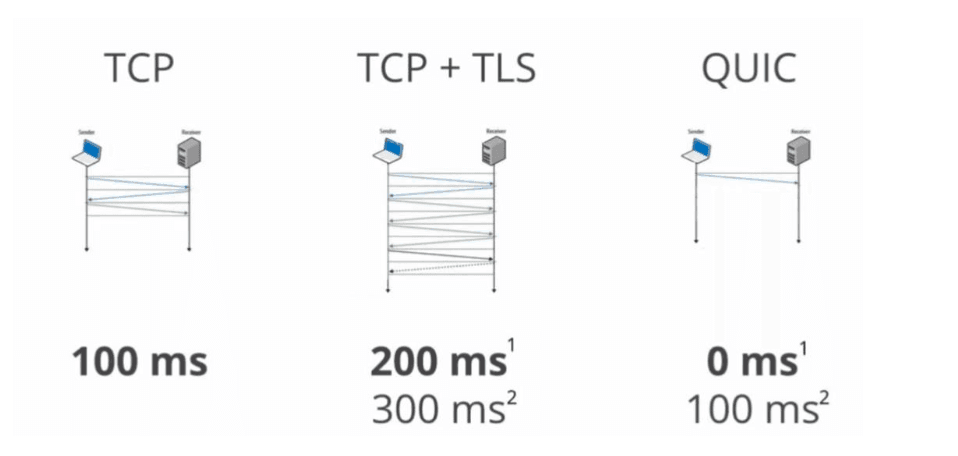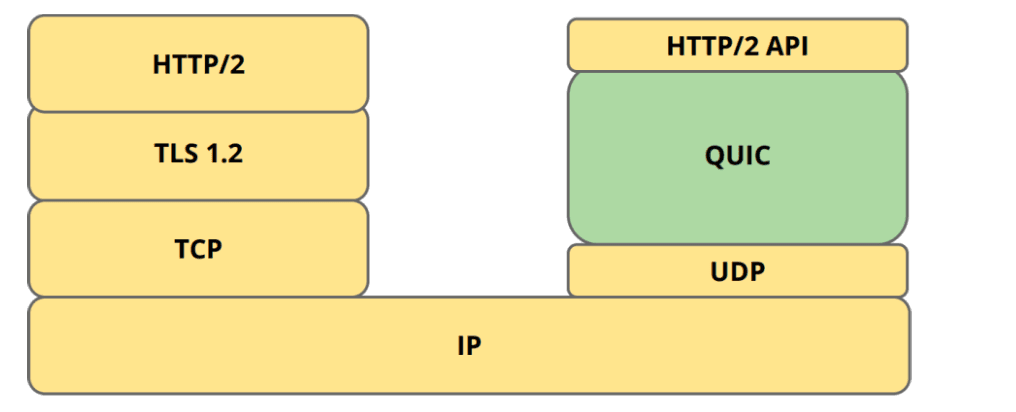インターネットプロトコルの絶え間ない進化の中で、QUIC(Quick UDP Internet Connection)は画期的な存在となっています。2013年にGoogleによって開発され、Chromiumプロジェクトに統合されたQUICは急速に普及し、現在ではHTTP/3の基盤となることが期待されています。本記事では、QUICの複雑さ、その従来のプロトコルに対する利点、そしてウェブ通信の未来への影響について掘り下げます。
QUICとは何ですか?
QUICはUDP(ユーザーデータグラムプロトコル)の上に構築されたトランスポート層プロトコルです。TCP(トランスミッションコントロールプロトコル)、TLS(トランスポート層セキュリティ)、およびHTTP/2の機能を単一の、より効率的なプロトコルに統合するように設計されています。公式QUICプロジェクトページによれば、QUICはUDP上にTCP+TLS+HTTP/2を実装していると考えることができます。
QUICの進化
- 2013年:GoogleがQUICを公表
- 2015年:IETF(Internet Engineering Task Force)がQUICをドラフト標準に含める
- 2018年:IETFがHTTP/3の基盤としてQUICを正式に発表
なぜQUICなのか?TCPの制限に対処
QUICはTCPのいくつかの長年の問題に対処するために開発されました:
プロトコルの硬直性:TCPの広範な実装により、オペレーティングシステムやネットワークデバイスでの修正や改善が困難になります。
接続確立の遅延:TCPのハンドシェイクプロセスは、特にTLSと組み合わさると、重要な遅延を引き起こします。
先頭のブロッキング:TCPの厳密なデータ順序付けは、パケットが失われたり再配信された場合に遅延を引き起こす可能性があります。
柔軟性の欠如:オペレーティングシステムレベルでのTCPの実装は、更新や改善を困難にします。
QUICの主な特徴と利点
1. 遅延の低減
QUICは接続確立時間を大幅に短縮します:
- 特定のシナリオでは0-RTT(往復時間)
- 一般的なケースでは1-RTT、TCPの3-RTTと比較して

2. 信頼性の向上
UDPに基づいているにもかかわらず、QUICは独自の信頼性メカニズムを実装しています:
- 高度な混雑制御アルゴリズム
- パケットの再送信
- 前方誤り訂正(FEC)
3. より良い接続移行
QUICはネットワーク間(例:Wi-Fiからセルラーへ)のシームレスな接続移行をサポートします。
4. ネイティブ暗号化
QUICはセキュリティ機能を統合しており、すべての接続がデフォルトで暗号化されます。
5. 先頭のブロッキングなしの多重化
QUICは単一の接続内で複数のデータストリームを許可し、あるストリームが他のストリームをブロックすることがありません。
6. フロー制御
QUICは受信者を圧倒しないように、高度なフロー制御メカニズムを実装しています。
QUICと従来のプロトコルの比較
以下の図は、QUICと従来のプロトコルスタックの比較を示しています:

実世界のアプリケーションと採用状況
多くの主要なインターネット企業がQUICを採用し始めています:
- Googleサービス
- Cloudflare
- Akamai
例えば、Tencent CloudのライブストリーミングサービスはQUICアクセラレーションを完全にサポートしています。Tencent CloudのクライアントSDKを使用することで、顧客はライブストリーミングの遅延を3-5秒から500msまで低減できます。
QUICの未来
QUICがHTTP/3の基盤となるにつれて、以下のことが期待されます:
- さまざまなインターネットサービスにおけるより広範な採用
- 継続的な改善と最適化
- ウェブブラウジング以外の潜在的なアプリケーション、IoTやリアルタイムコミュニケーションなど
結論
QUICはインターネットプロトコル技術における重要な飛躍を示しています。TCPの制限に対処し、現代のセキュリティとパフォーマンス機能を組み込むことで、QUICはより迅速で信頼性の高いインターネットの基盤となることが期待されています。それが進化し、採用が進むにつれて、開発者や企業はQUICについて最新情報を把握し、自らのウェブサービスへの実装を検討すべきです。
QUICに関する詳細情報は、公式QUICプロジェクトページをご覧ください。